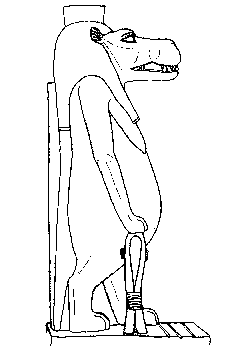
Taweret, also known by the Greek name Thoeris, is one of the names given to a hippopotamus goddess, the others being Opet and Reret. Iconographically, these goddesses cannot be differentiated from each other. They are composite creatures with the body of a pregnant hippopotamus, the back of a crocodile, lion's paws and human hands.
The most important functions of hippopotamus goddesses are those of mother and nurse. Their most important attributes are the protective sa-loop and the ankh-sign, and they have a mainly apotropaic function at weddings and births. They also assisted at the rising of the sun, which was sometimes regarded as birth from a mother goddess. Depictions of hippopotamus goddesses appear on magical knives, on chairs, headrests and beds, and amulets with depictions of a hippopotamus goddess have even been found in houses in Amarna. In the New Kingdom she appeared as the constellation of the northern skies, often with a crocodile on her back. From the 26th Dynasty on, she also acquired the function of a month goddess.
The name Taweret, which means 'the large one', may date back to the early New Kingdom and probably comes from association with mother goddesses such as Hathor and Isis. The link with Hathor is a common one; Taweret often wears the cow's horns and sun disk that are characteristic of Hathor. She was particularly revered in the area around Thebes; many libation vessels and stelae have been found at Deir el-Medina showing Taweret alongside Hathor. She had a special role at Gebel es-Silsila (Eg. Kheny), 145 km south of Luxor where the river is very narrow. As 'imiw-nnw', she was linked there with the annual innundation and is depicted in several chapels with the face of a woman and the Hathor headdress.
Incidentally, male hippopotami were regarded as destructive and associated with Seth.